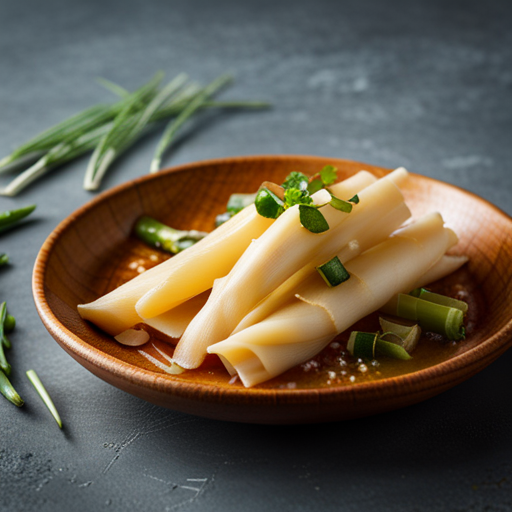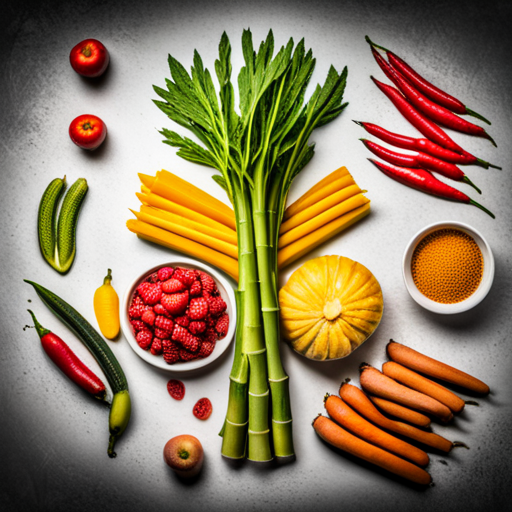Bamboo, a widely used grass in Asian cuisine, possesses a distinct taste and flavor profile. This article aims to explore the taste of bamboo, focusing on its unique characteristics and culinary applications.
Bamboo shoots, the most commonly consumed form of bamboo, offer a slightly sweet and nutty flavor with a crisp texture. When cooked, bamboo exhibits similarities to the taste of asparagus or spinach.
Apart from its culinary appeal, bamboo also provides numerous health benefits. It is rich in fiber, antioxidants, and essential vitamins such as A, C, and E. Consuming bamboo promotes gut health, aids in lowering cholesterol levels, and reduces inflammation.
Furthermore, bamboo contributes to environmental sustainability. It grows rapidly, preventing soil erosion, and has a remarkable ability to absorb carbon dioxide, thereby reducing greenhouse gas emissions. Moreover, bamboo’s strength and durability make it a valuable material in construction and furniture making.
With its culinary and environmental advantages, bamboo emerges as a remarkable and versatile resource.
Contents
Our Highlighted Points
- Bamboo has a mild, slightly sweet flavor.
- Bamboo shoots are the most common form of bamboo used in cooking and have a slightly sweet, nutty flavor.
- Bamboo has a similar flavor to asparagus or spinach when cooked.
– Bamboo is high in fiber and antioxidants, making it a nutritious addition to meals.
Taste and Flavor

The taste of bamboo is characterized by its mild, slightly sweet flavor, which is comparable to that of asparagus or spinach when cooked. Bamboo is commonly used in Asian cuisine, particularly in stir-fries and other dishes. Its flavor is often described as having a nutty undertone.
When bamboo shoots are cooked, they become tender and have a crisp texture. In terms of culinary applications, bamboo can be stir-fried, steamed, boiled, or made into soup. It is a versatile ingredient that can be incorporated into various dishes.
In comparison to other vegetables, bamboo shares similarities with asparagus and spinach in terms of taste and flavor, although it has its own unique characteristics.
Cooking and Preparation Methods

One common method of preparing bamboo shoots is by stir-frying, steaming, boiling, or making them into soup. These cooking techniques are popular in Asian cuisine and help to bring out the unique flavors and textures of bamboo shoots.
Stir-frying allows the shoots to retain their crispness, while steaming or boiling can soften them for a more tender texture. Making bamboo shoots into soup allows for a more concentrated flavor and can be a comforting dish.
In addition to their culinary uses, bamboo shoots hold cultural significance in many Asian countries. They are often featured in traditional dishes and festivals, symbolizing good luck, abundance, and prosperity.
The versatility of bamboo shoots in cooking and their cultural significance make them a valuable ingredient in Asian cuisine.
Nutritional Value and Benefits

Nutritional analysis reveals that bamboo shoots are rich in fiber, vitamins, minerals, and antioxidants, making them a valuable addition to a healthy diet.
Bamboo shoots are low in calories and fat, yet they provide a good source of nutrients. They are particularly high in fiber, which promotes healthy digestion and aids in weight management.
Bamboo shoots also contain vitamins A, C, and E, which are important for immune function, skin health, and cell protection. Additionally, they are a good source of minerals such as potassium, magnesium, iron, and copper, which play essential roles in various bodily functions.
The antioxidants found in bamboo shoots help to reduce inflammation and oxidative stress, potentially lowering the risk of chronic diseases.
Incorporating bamboo shoots into your diet can be done through various bamboo recipes, such as stir-fries, soups, and salads, allowing you to reap their health benefits.
Does the Taste of Bamboo Have Any Connection to Its Flowers?
The taste of bamboo does not have any direct connection to its flowers. However, the appearance of bamboo flowers can provide insights into the plant’s life cycle and growth patterns. Understanding bamboo flower appearance insights can be valuable for those studying or cultivating bamboo.
Frequently Asked Questions
How tall can bamboo grow?
Bamboo can reach heights of up to 100 feet. Its cultivation techniques make it a versatile and sustainable building material. Bamboo’s rapid growth, strength, and durability make it a popular choice for construction and furniture manufacturing.
How many species of bamboo are there?
There are over 1,000 species of bamboo. Bamboo cultivation is widespread in Asia for various purposes, including construction and furniture making. It is valued as a building material due to its strength, durability, and environmental benefits.
Can bamboo shoots be eaten raw?
Bamboo shoots can be eaten raw, but they are commonly cooked before consumption. Cooking bamboo shoots enhances their flavor, improves their texture, and increases their digestibility. Additionally, cooking helps to release the nutritional benefits of bamboo shoots, such as their high fiber content and the vitamins A, C, and E they provide.
What is the compound in bamboo that gives it a woody flavor?
The compound in bamboo that gives it a woody flavor is bamboo Yunshanzhusuo. This compound contributes to the culinary uses of bamboo, as it adds a distinct taste to dishes such as stir-fries and soups.
What are some environmental benefits of bamboo?
Bamboo has several environmental benefits, including its use in sustainable construction and as a renewable resource for paper production. These applications contribute to preventing soil erosion and reducing greenhouse gases, making bamboo an eco-friendly choice.

